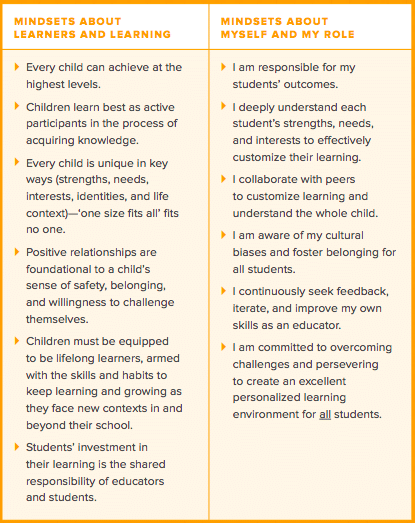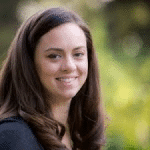VOICES: Stacey Wang and Jane Bryson on Developing Teacher Mindsets
CompetencyWorks Blog
 This is the third post in a ten-part series that aims to make concepts, themes, and strategies described in the Moving Toward Mastery: Growing, Developing and Sustaining Educators for Competency-Based Education report accessible and transferable. Links to the other articles in the series are at the end of this post.
This is the third post in a ten-part series that aims to make concepts, themes, and strategies described in the Moving Toward Mastery: Growing, Developing and Sustaining Educators for Competency-Based Education report accessible and transferable. Links to the other articles in the series are at the end of this post.
What mindsets matter for teachers in competency-based, personalized classrooms? How do we know? How can leaders help teachers shift existing mindsets and develop new ones? These are questions that teachers and leaders grapple with every day. Moving Toward Mastery communicates the importance of developing teacher mindsets, but does not provide specific strategies for how to do this work. This post picks up where the paper left off. I co-authored this post with leaders from Transcend Education, Stacey Wang and Jane Bryson. We reflect on a few big questions. What are mindsets? Can you change them? If so, how? And, how do we do this in our own work?
Background
The “Mindsets Project” did not start as such. Initially, Lindsay Unified School District, Summit Public Schools, Transcend Education, and Columbia University’s Center for Public Research and Leadership came together to co-create a student impact model that would help define quality personalized learning (see Figure 1). As we developed this model, we realized that teacher and leader mindsets have a huge impact on student outcomes and that we needed to make these mindsets more explicit. We studied mindsets research, reflected on hiring practices and success conditions at Lindsay and Summit, and engaged experts around the country. Through this process we found that there are six critical mindsets for teachers to hold about “learners and learning,” and six critical mindsets about “myself and my role.” These are shown in Figure 2 and explained in more detail in An Early Inquiry into Educator and Leadership Mindsets.


What are mindsets?
Mindsets shape everything a teacher does: how they define their own role, how they think about their students’ abilities, how they teach and how they assess student learning. Changing mindsets often start with reframing our ideas about what mindsets are. Research suggests that a mindset is not something you either “have” or “don’t have.” A mindset is something you are either “in” or “not in.” A mindset is a habitual way of thinking, seeing the world and making meaning. Actions are more closely related to mindsets — specifically, to the ways we inhabit and enact our mindsets within a given context — than they are to beliefs. Often the things we say we believe and the things we actually do are not the same. Ross Lipstein, Senior Director of Research at Summit, explained it this way. “It’s [how you bring] a mindset to a context that counts, not what you believe in theory.”
Can mindsets be changed?
Simply put, yes. Our research shows that it is possible to change mindsets. But, this involves real work. It requires uncovering underlying competing beliefs and values, listening to the people we work with and for, and engaging in continuous coaching and reflection.
How can mindsets be changed?
To answer this question, we have pulled together the following ideas for actions, examples of systems actually doing this work and additional resources.
- Dedicate and align resources to the work. Systems, teams and individuals need space, time and proven practices to investigate their mindsets and how they play out in context. This means dedicating time to reflection and coaching. To start doing something new, you often have to stop doing something else. In Lindsay Unified, every meeting refers back to the district’s strategic design including core values about student learning such as mindsets. If a meeting can not be linked to the strategic design, the meeting is cancelled. Lindsay also dedicates resources to coaching about mindsets, helping educators and site leaders make space to reflect and combat any constricting mental models.
- Make mindsets explicit. Many mindsets are held implicitly. Changing them starts with making them explicit. This means more than putting them in a strategic document that lives in a binder. This means making it clear what teacher mindsets are aligned with student success. Then, it means making teachers aware of the mindsets they bring to their work. This happens through continuous reflection, asking questions such as “What mindsets truly underlie what we do? What mindsets are we bringing to our work, based on the actions we take and the outcomes we see? Are these mindsets aligned to our stated beliefs and values? If not, how can we realign them?”
Mindsets can also be kept explicit by continuously reflecting on the alignment of actions and priorities. Some Summit Learning sites have begun using a Summit-designed approach to instructional coaching to support teachers in their transition to personalized learning. At these sites, coaches begin work with educators by aligning on a set of commitments. Educator and leadership commitments are co-created based on mindsets research and from research about what needs to be true for students to learn effectively as described by the Building Blocks for Learning (Stafford-Brizzard, 2016). Transcend, Lindsay, and Summit developed tools that can help adults reflect on situations or contexts when they were more or less “in” a mindset (see Figure 3). We find this to be a helpful structure for making people aware of their mindsets in action.

- Focus on equity. Reflecting on mindsets almost always requires reflecting on equity. Why? Because many of our beliefs about learning are steeped in seen and unseen biases. It takes truly understanding our own perspectives and blind spots to be able to be aware of biases we hold that may not serve our work. To continuously keep equity at the forefront, a diverse leadership team and an inclusive process are essential. Leaders should continually ask themselves, “Who’s leading? Who’s at the table making decisions with and for our community? Is the decision-making body representative of our entire student population and the community we serve? How might we purposefully bring in voices from the community that are less frequently heard?”
If you want to continue learning about these issues, here are a few resources on mindsets and behaviors:
- The Power of Habit
- Immunity to Change
- Disruptive Equity Education Project
- How to Get to Quality Personalized Learning
- Made to Stick
- The Power of Moments
- Switch
Reflections
Ross Lipstein: “There are three things that stand out to me about how to help educators evolve their mindsets. First, surface and change beliefs that are actually untrue using learning science, counterexamples, boundary tests and other methods. Second, help people build self-awareness about when they are or aren’t in certain mindsets, even if they agree with that mindset in theory. Over time, this can help people notice patterns in themselves and recognize and change in the moment. Finally, recognize behavioral manifestations of certain mindsets. This will help educators see when mindset strengths and growth areas crop up. It’s difficult to recognize them until you curiously probe.”
Stacey Wang: “I have become more explicit with teachers and others in the field around mindsets: why I have them and why I believe they have the power to change lives for learners everywhere. I recognize that we all have a lot of implicit beliefs that operate our explicit actions, and my role is to both recognize and verbalize my ‘why’s’ as well as create space for others to interrogate their own beliefs and values and question for themselves if those beliefs are helpful to learners and their work in education.”
Jane: “Mindset work is continuously evolving. Awareness is a critical first step, and growth often involves a community or thought partnership based on trust and desire to grow professionally. Personally, when I reflect on my actions or what mindset I’m bringing to a challenging situation, I have to deliberately counteract the narrow experience and perspective I bring by checking my assumptions, getting curious, and listening deeply. Having mentors and critical friends who support my work and hold up a mirror to my actions and beliefs in support of my development has been incredibly helpful in this work, and I strive to do the same with my partners.”
Katherine: “I have learned that it is not helpful to focus on how I appear. When my energy is investing in trying to appear unbiased, it is not invested in recognizing, acknowledging, and addressing the ways that I am. For me, getting past the appearance game started with destigmatizing bias. Destigmatizing is not the same as trivializing; biases can be powerful forces that do harm, and I feel a huge amount of urgency to address them. Destigmatizing just means acknowleding that biases are real, recognizing that everyone has them, and working past my own shame about them so I can do something about them.”
Read the entire series:
| Introducing VOICES Co-Authors
|

Jane Bryson is a Partner at Transcend Education and comes to Transcend with 15 years of experience as an teacher, in school leadership, and rethinking school models to personalize learning. In her school leadership roles, she acted as a lead teacher, department head, and ran both a service-learning and early college program. Prior to working at Transcend, Jane spent four years building and leading the consulting team at Education Elements, a personalized learning consulting firm, where she had the pleasure of partnering with some of the earliest innovators around blended and personalized learning. Jane has also worked at NewSchools Venture Fund and the Federal Department of Education, on the Race to the Top initiative. Jane has an Masters of Business Administration, Masters of Education and Bachelor’s degree in History from Stanford University. |
 Stacey Wang is a Partner at Transcend Education dedicated to accelerating innovation in the core design of “school.” Prior to joining Transcend, Stacey Wang served as the Advisor of the Superintendent and Director of Personalized Learning for Oakland Unified School District where she collaborated with system leaders, school leaders, teachers, parents, students, and the broader community to transform schools from traditional models to personalized learning schools impacting over 7,000 students. Before that, Stacey worked at Monitor Deloitte in the strategy practice where she helped Fortune 100 companies and nonprofits design strategies for large scale organizational change. As part of her work in innovation, she ran a team at the Center for the Edge developing pragmatic frameworks for systemic innovation.Stacey pursued an MBA at Columbia Business School with a focus on social entrepreneurship and nonprofit management and has an undergraduate degree from UC Berkeley, Haas School of Business.
Stacey Wang is a Partner at Transcend Education dedicated to accelerating innovation in the core design of “school.” Prior to joining Transcend, Stacey Wang served as the Advisor of the Superintendent and Director of Personalized Learning for Oakland Unified School District where she collaborated with system leaders, school leaders, teachers, parents, students, and the broader community to transform schools from traditional models to personalized learning schools impacting over 7,000 students. Before that, Stacey worked at Monitor Deloitte in the strategy practice where she helped Fortune 100 companies and nonprofits design strategies for large scale organizational change. As part of her work in innovation, she ran a team at the Center for the Edge developing pragmatic frameworks for systemic innovation.Stacey pursued an MBA at Columbia Business School with a focus on social entrepreneurship and nonprofit management and has an undergraduate degree from UC Berkeley, Haas School of Business.